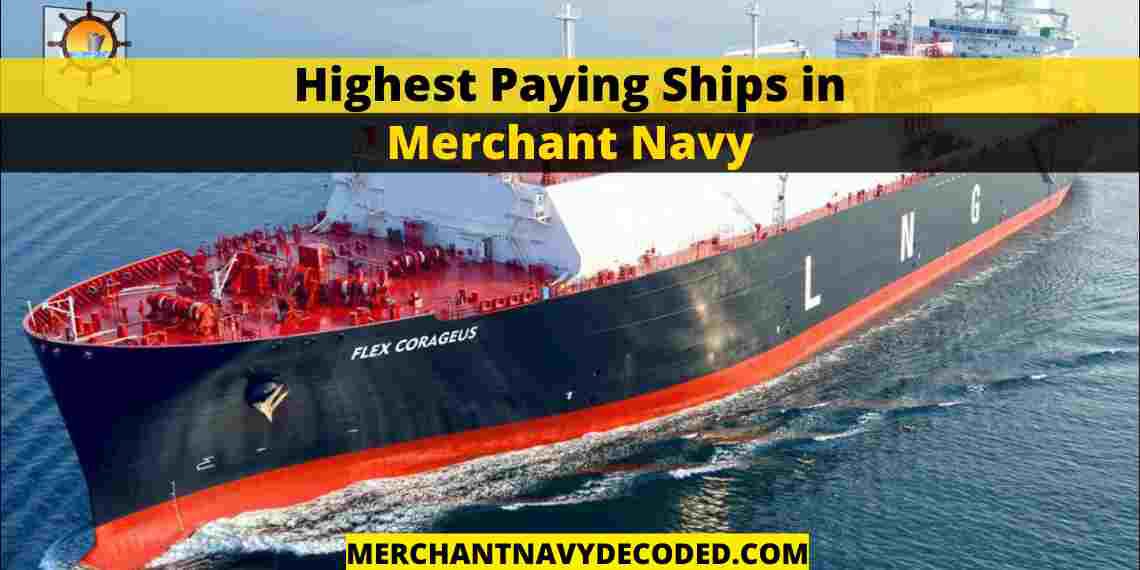Highest Paying Ships in Merchant Navy
Most people join Merchant Navy with dreams of earning large sums of money at an early age and traveling the world. Over the years this profession has proved to be one of the highest-paying career options in our country. Even though in the last few years there has been a lot of debate regarding the future of upcoming seafarers in this profession and whether it will have the same opportunities as it used to have a decade ago. However, presently this profession still continues to offer plenty of new opportunities for up-and-coming seafarers. And continues to offer lucrative salaries to the people sailing onboard merchant vessels. In this blog, we are going to write about the highest-paying ships in Merchant navy.

Highest Paying Tanker Ships in Merchant Navy
Seafarers sailing onboard Tanker ships are paid more than those sailing in dry ships such as Bulk carriers, RO-RO ships, and Container ships. Below we are going to list some of the highest-paying Tanker ships in merchant navy.
| Rank | LNG Carrier | LPG Carrier | Chemical Tanker | Oil/Product Tanker |
| Captain/Chief Engineer | 18,000$-20,000$ | 12,000$-15,000$ | 12,000$-15,000$ | 12,000$-14,000$ |
| Chief Officer/2nd Engineer | 12,000$-14,000$ | 9,000$-12,000$ | 9,000$-11,000$ | 9,000$-11,000$ |
| 2nd Officer/3rd Engineer | 5,000$-6,000$ | 3,500$-5,000$ | 3,500$-5,000$ | 3,500$-5,000$ |
| 3rd Officer/4th Engineer | 2,500$-4,000$ | 2,200$-3,500$ | 2,200$-3,500$ | 2,200$-3,500$ |
| ETO | 8,000$-10,000$ | 5,000$-7,000$ | 4000$-5000$ | 4000$-5000$ |
| Deck Cadet/5th Engineer | 350$-750$ | 350$-750$ | 350$-750$ | 350$-750$ |
1. LNG/LPG Tankers

As the name suggests LNG tankers transport liquified natural gas and compressed natural gas. While LPG tankers transport liquified petroleum gas such as butane, propane, butadiene, etc. These tankers are more technologically advanced than any other form of vessel, including bulk carriers, container ships, and other types of tankers. Since these tankers carry really very high-value cargo, therefore the salaries are also high in these vessels.
2. Chemical Tanker

Chemical tankers frequently incorporate specialized cargo systems, tailored to transport a variety of liquid chemicals such as palm oil, vegetable oil, tallow, methanol, caustic soda, etc. These tankers are designed to maintain the uniformity of the chemicals that they transport. To guarantee that the cargo retains its purity when placed into a multi-purpose tank, these systems may also contain heating or cooling apparatus, as well as modern cleaning systems.
3. Crude Oil/Product Tankers

Crude oil tankers transport an enormous amount of crude oil from their site of extraction to the refineries, where it is further processed. Crude oil tankers usually carry one grade of cargo at a time. Product tankers are smaller tankers with a capacity of up to 35,000 tonnes that are usually built to carry chemical cargoes, necessitating special design and equipment such as stainless steel cargo tanks, corrugated bulkheads, deep well pumps, and more complex piping systems. Product tankers transport refined oil (of various grades) to a location near the final market.
Highest Paying Dry Ships in Merchant Navy
Dry ships pay a smaller amount of salary as compared to tankers. There are various kinds of dry ships in merchant navy which include Bulk carriers, Container ships, RO-RO vessels, Passenger/Cruise vessels.
| Rank | Bulk Carrier | Container Ship | RO-RO |
| Captain/Chief Engineer | 8,000$-10,000$ | 8,000$-10,000$ | 8,000$-10,000$ |
| Chief Officer/2nd Engineer | 6,000$-8,000$ | 6,000$-8,000$ | 6,000$-8,000$ |
| 2nd Officer/3rd Engineer | 3,200$-4,500$ | 3,200$-4,500$ | 3,200$-4,500$ |
| 3rd Officer/4th Engineer | 2,200$-3,500$ | 2,200$-3,500$ | 2,200$-3,500$ |
| ETO | 4,000$-5,000$ | 4,000$-5,000$ | 4,000$-5,000$ |
| Deck Cadet/5th Engineer | 350$-750$ | 350$-750$ | 350$-750$ |
1. Bulk Carriers

Bulk carriers carry unpackaged dry goods having a high weight-to-cost ratio, such as coal, grain, and ore. A bulk carrier has no walls, yet the middle deck is installed to keep the cargo from being pressed. To keep the cargo from tilting to one side, it contains a topside tank and a hopper tank. These ships are separated into multiple different holds, each of which is protected by a hatch. Cargo is loaded at the port using a conveyor and spouts, or a crane and grab. Some bulk carriers are outfitted (typically with a crane between each hatch) to allow goods to be loaded and unloaded at ports, without the need for shore equipment. A Vast fleet of Bulk Carrier acts as an important indicator of global trade.
2. Container Ship

Container ships are among the largest boats on water, and are mostly employed on liner routes. Containers have become a primary mode of transport for manufactured products throughout the world, and are of a standard size to make shipping easier. The containers are inserted onto vertical frames or guides in their cellular holding. Containers are often loaded either by specialized cranes, or general-purpose cranes equipped with container lifting accessories. While self-loading and unloading is possible on some small cargo ships.
3. RO-RO Vessels

RO-RO (roll-on/roll-off) ships are cargo ships that transport wheeled products such as cars, trucks, semi-trailer trucks, buses, trailers, and railway carriages. These ships allow freight to be driven right on and off, making it a conducive mode of transportation. Their classifications include PCC (Pure Car Carriers) and PCTC (Pure Car & Truck Carriers), all of which fulfil the same purpose. In contrast to shipping cargo, which is determined by multiplying the cargo length in meters by the number of decks and lanes, Ro-Ro freight is measured in lane meters.
4. Passenger/Cruise Vessels

Cruise Ships are designed to provide customers with housing and entertainment, while specifically focussing on onboard amenities and comforts. Cruises are designed to transfer guests between ports according to a holiday itinerary, rather than from one location to another. The largest cruise ship can accommodate over 6,500 guests along with 2,000 crew members, making the cruise business a major source of employment generation in the Marine Industry.
I hope that after reading this blog most of you guys now have a better understanding of the salary in merchant navy for different kinds of vessels. Therefore, if you want to earn high salary in this profession, try to start your career by sailing onboard tankers.
Disclaimer :- The opinions expressed in this article belong solely to the author and may not necessarily reflect those of Merchant Navy Decoded. We cannot guarantee the accuracy of the information provided and disclaim any responsibility for it. Data and visuals used are sourced from publicly available information and may not be authenticated by any regulatory body. Reviews and comments appearing on our blogs represent the opinions of individuals and do not necessarily reflect the views of Merchant Navy Decoded. We are not responsible for any loss or damage resulting from reliance on these reviews or comments.
Reproduction, copying, sharing, or use of the article or images in any form is strictly prohibited without prior permission from both the author and Merchant Navy Decoded.



Logistics plays a significant role in everything from getting products onto store shelves to making sure your online orders arrive on schedule.
Hey I have many queries regarding this job so plz contact me so that I can clear my queries
Hi Pratik, you can submit your queries in our ‘Ask you Query’ section or you can call us at 7417349336 and we will revert back as soon as possible.
I have to join v ships n I have apply my CV,pls guide me
Hey there, if you have submitted your CV then there is only one more thing that you can do which is to apply in colleges like TMI where V ships usually come every year.
Admission for eto
Check our “free ETO Guidance Series” to learn the joining process, best ETO Colleges, fees and their salary in the Merchant Navy.
Please help me where do I get training for cruise ships
Hey currently we do not offer any services or guidance for the cruise. So, we can’t recommend you anyone for the guidance.
Study in class 9th
Hi Ayushman, if you want to join merchant navy then I suggest you focus on your class 10 boards and then opt PCM and get a good score in 12th boards. This is the only thing you should focus on right now.
Urgent joining as oil Tanker vessels as Pumpman ready to join at times
Hi Shahid, we cannot help you to place in a shipping company, of there is any thing else where you want our help, you can let us know and we will try to provide the information as soon as possible.
Hello sir I just completed my class 4 coc exam now I want to know about advance course chemo course is compulsory to do if I want to sail on crude oil tankers or product oil tankers please tell me sir
Hi Vikram, if you want to sail on crude oil tankers then you need to apply for TASCO course which is necessary to do if you want to join the crude oil tanker.